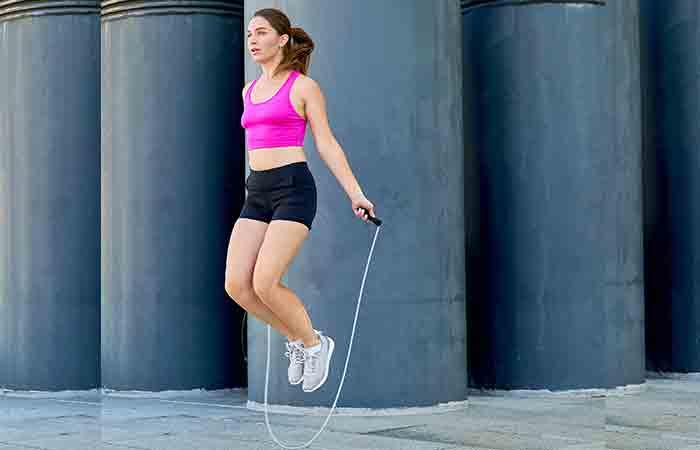Exercise that is both enjoyable and beneficial for boosting immunity and improving overall health.
evaluated medically by RD Madhu Sharma
Written by ISSA Certified Fitness Nutritionist Charushila Biswas, MSc (Biotechnology).
BSc, Professional Certificate in Food, Nutrition, and Health holder Ravi Teja Tadimalla edited this work.
Moksha Gandhi, BPharm, Certified Health & Wellness Coach, verified the information on February 22, 2024.

Is skipping beneficial to you? Yes, rope jumping is an excellent workout regardless of your goal—burning calories or warming up. Rope jumping or skipping has numerous advantages. A minute of this full-body exercise burns ten to fifteen calories. It’s excellent for toning up your body, reducing excess fat, and enhancing the cardiometabolic process. Take a look at these advantages of skipping rope.

- Frequency: 3–5 times per week
- Benefits: Improves blood circulation, aids weight management, improves coordination, and enhances muscular endurance
- Equipment Needed: Jump rope
- Space Required: Medium-sized area to move the rope
- Assistance Required: No
- Who Should Avoid: Pregnant individuals or anyone with a joint problem or lower body injury.
0:10 / 0:56
In This Article
- Benefits Of Jumping Rope
- How To Start Skipping
- Duration Of Rope Skipping
- Infographic: Benefits Of Skipping
- Frequently Asked Questions
- Key Takeaways
Benefits Of Jumping Rope
1. May Improve Heart Health

Skipping or rope jumping is a great form of cardio exercise. It increases the heart rate. This allows the heart muscles to work harder to pump oxygenated and deoxygenated blood across the body, thereby promoting heart health and gain height.
A 12-week study on the effect of skipping on children stated that rope jumping might help reduce the risk of cardiovascular disease in younger populations (1).
2. Tones The Lower And Upper Body
Rope skipping or skipping benefits your entire body. It is a great full-body workout that helps shed fat from all parts of your body and tones you up. Jesse Feder, RD, CPT, CSCS, says, “Skipping rope is an exercise that can get your heart rate up quite easily and for the entire duration of the exercise. This really helps burn a significant amount of calories and can put you into a caloric deficit for the day, which leads to fat loss.” It will not help build lean muscle, but if you do it at a higher intensity, you will work your biceps, triceps, shoulders, calves, thighs, and glutes and may improve lower body strength as well.
Jeremiah Daniel, a fitness trainer, says, “You can also combine rope jumping with exercises that specifically target the glutes for better and quicker results, but keep in mind it’s generally harder to grow muscle if you’re in a calorie deficit.”
Related: 16 Lower Body Workouts For Women For Toned Legs And Hips
3. Burns Calories

Skipping or jumping rope is an amazing way of calorie burning and shed fat. In a study, scientists found that rope jumping to dance music helped improve BMIi more than stationary cycle exercise (2). According to a study, 10 minutes of rope jumping is equal to 30 minutes of jogging for improved cardiovascular efficiency (3).
Start with a short session of 2-3 minutes of jumping rope every day. Increase the duration and intensity as you progress.
Alfiya, a lifestyle and fitness YouTuber, tried rope jumping for 7 days and found out that by the end of the challenge, her heart rate increased and she lost weight. She says, “My heart rate went up. It’s a really nice cardio exercise for you to do, you know it’s not that high intensity as well (i).” She reduced her waist circumference from 31.5 to 30 inches with rope jumping. She adds, “I lost 1.5 inches! I was not expecting it at all.”
Related: 6 Best Chair Cardio Exercises To Burn Calories
4. May Improve Motor Function And Stamina
This is the reason most athletes, and especially boxers, practice jumping rope. Adding skipping or rope jumping and weighted rope jumping to your exercise routine can help improve coordination, strength, muscular endurance, and balance in young athletes (4), (5).

Related: 5 Effective Yoga Poses To Increase Your Stamina
5. May Improve Pulmonary Function
Jumping rope improves circulation and breathing and enhances lung capacity (2). A study assessed that long-term aerobic exercise showed a positive influence on cardiorespiratory functions and maximal oxygen uptake (6).
6. Can Improve Bone Density

Osteoporosis and weak bones are direct causes of low bone density. Jumping rope regularly can cause bone density improvement (7). However, further research is required to understand how the duration, frequency, and intensity of rope jumping can affect bone mineral density. Moderate-intensity rope jumping is also safe for people with osteopeniai and can help increase hip bone mineral density (8).
7. May Boost Mental Health
Jumping rope with moderate intensity may have positive effects on anxiety, depression, and mood. Exercise may increase body temperature and blood circulation in the brain (9). This, in turn, may help in stress relief and improve cognitive dissonancei and mental clarityMyths & Facts about Laser Hair
8. Is Easy On Your Joints

Low-intensity jump rope benefits your joints. It is easy on them and, thereby lowers the risk of injury to the knees or any other joint. The results of a study indicated that jump-rope training might improve the shoulder movement of overhead athletes (10).
9. May Improve Coordination
One of the most significant benefits of skipping ropes is improved coordination. While it may seem like a simple activity, it requires precise synchronization of your hands, eyes, and feet. As you jump over the rope, your body and brain work together to time your jumps, maintain balance, and ensure the rope clears beneath your feet. Over time, this practice enhances your hand-eye coordination, rhythm, and overall motor skills (5). In fact, it is not just about jumping, but also about maintaining a consistent rhythm and making split-second adjustments. This improved coordination enhances your agility and overall physical dexterity.

There are many skipping rope exercises you can try out, from criss-cross skipping and jump skipping to high-knees skipping. These exercises keep you on your toes and healthy.
Note: You must not try rope jumping right after surgery or a critical injury – not until your doctor and physical therapist give you a nod.
Jumping rope is an easy, effective, and simple aerobic exercise that provides a host of benefits – so blast some music and sweat it out! You can also include a 5-minute fat-burning skipping in your exercise routine to warm you up to enjoy the benefits of jumping rope.
How To Start Skipping
- Adjust the length of your rope.
- Hold the handles at the ends of the rope – one in each hand.
- Step in the middle of the rope, keeping the length taut with the ends stretched upwards. Shorten the rope until both ends reach your armpits.
- Step in front of the rope and swing it from the back to the front.
- As the rope reaches your feet, jump. Keep your legs straight.
- Land softly on the floor.

Pair skipping rope exercises with other training workouts like cardio, strength and resistance training, High-intensity interval training (HIIT), and calisthenics to create the best workout.
Duration Of Rope Skipping
Start with 1-minute rope jumps. Increase the intensity and duration of rope skipping as you become comfortable. Increase the duration every week by at least 1-2 minutes. You should be able to jump rope for 10-15 minutes. Make sure to take breaks, sip on your electrolyte drink, and get jumping again.
Feder says, “Anytime you adopt a new exercise routine, you will likely see results within the first month of doing it, especially if you are new to exercising overall. However, if you are generally in good shape and already exercise, you may need to stick with it for up to 3 months before really noticing any changes. Additionally, if you do not see results within this time period, it does not necessarily mean it is not working. It could mean you need to increase the time and/or intensity of the exercise.”
Precautions
- Warm-up for at least 10 minutes before jumping rope.
- Wear shock-absorbing shoes.
- Wear a sports bra to prevent the sagging of breasts.
- Sip electrolyte water before and after a workout.
- Cooldown by stretching.
Avoid Rope Jumping If
- You have heart problems. Do it only if your doctor gives you a green signal.
- You are recovering from a serious illness or surgery.
- You have high blood pressure. Take your doctor’s opinion.
- You have a bone injury.
Infographic: Benefits Of Skipping
Exercising with a skipping rope has many benefits, such as burning calories, toning the body, and improving heart health.
If you are new to skipping, it can be tough to decide how often or how much time you should dedicate to this exercise. If you push too much, you can tire yourself and risk an injury. The key is to keep pushing yourself a little more than you did the previous day.
If you are a beginner, check out the infographic below to understand how much you should skip per week.

Skipping is a great way to burn calories and shed those extra pounds you have gained. From improving your cardiovascular fitness to endurance training, it enhances your lung capacity and reduces anxiety and depression, the benefits of skipping are wide-ranging. It is ideal for beginners to go for 1-minute rope jumps and gradually increase it by one or two minutes every week. Make sure you warm up your body before skipping, and invest in good shock-absorbing shoes and a sports bra. If you have any heart or blood pressure issues, consult your doctor and proceed only if you get the go-ahead.
Frequently Asked Questions
What happens if I jump rope every day?
Daniel says, “You could start to feel some of the benefits of regularly engaging in cardio exercises, such as good cardiovascular health, coordination improvement and increased agility, improved sleep, and reduced anxiety. If your goal is weight loss, then ultimately, you should rely on following a healthy diet as this promotes weight loss. Any type of exercise is very much useless unless you change your diet, and jumping rope is no different.”
Is skipping alone enough to lose weight?
Feder says, “Skipping alone is enough to lose weight, however, only if done consistently for a good amount of time and intensity. If you were to just skip rope once a week, you would most likely not lose weight. However, if you are able to skip rope daily or at least 2-3 times a week for 30-45 minutes at an intensity that gets your heart rate up, then you will more than likely start to see weight loss. An easy indicator to see if you are working at a good intensity is if you are breathing heavily and sweating throughout the exercise.”
Is 1000 skips a day good?
It depends on your age, fitness levels, purpose, and intensity of the workout.
Does skipping affect breast size?
Skipping doesn’t affect breast size, but it may bring about changes to their shape and form if you don’t support them well enough with a well-fitted sports bra.
Is skipping better than running?
Both are good and effective ways to burn calories. It depends on your preference for the day. While running can give you a wholesome experience of the outdoors, skipping doesn’t require much space and can be done anywhere.
Is jumping rope good for abs?
While it helps you lose calories, jumping rope doesn’t target your abdominal muscles.
Key Takeaways
- Skipping rope promotes your heart’s health. It helps your heart muscles work harder to pump oxygenated and deoxygenated blood.
- Rope jumping will improve your lung capacity and promote great cardio respiratory health as it helps in maximum oxygen intake.
- If you have weak bones, you should try skipping rope as it helps to increase bone mineral density.
- To start skipping, always adjust the length of the rope according to your height to avoid any slips.
